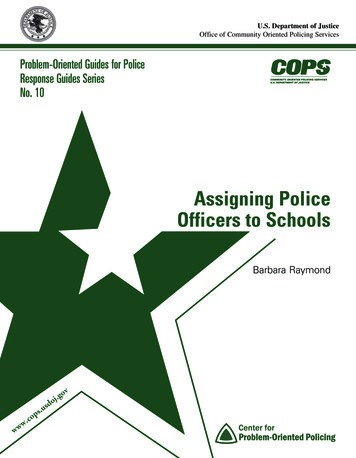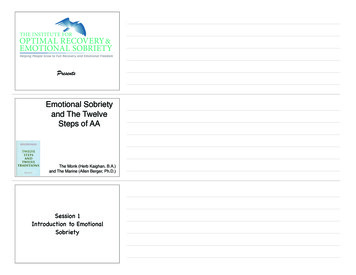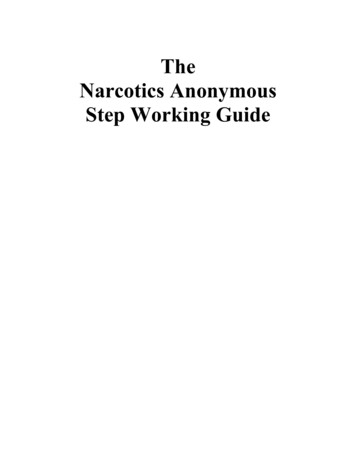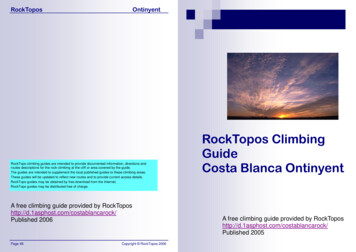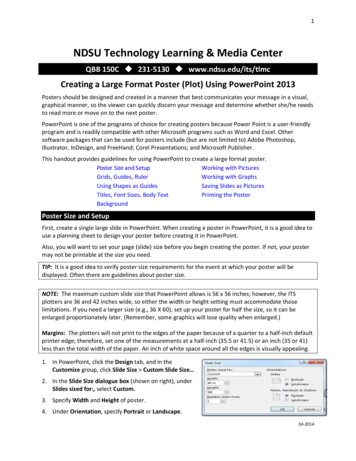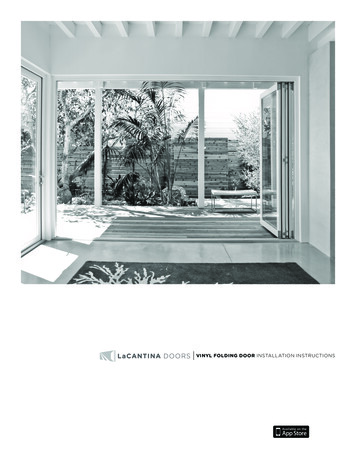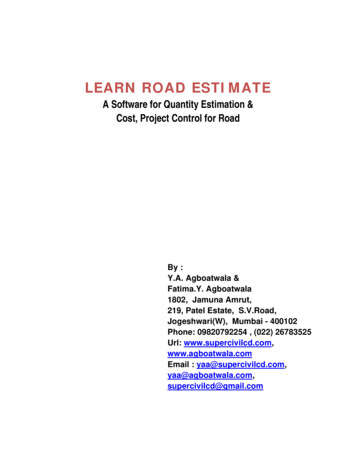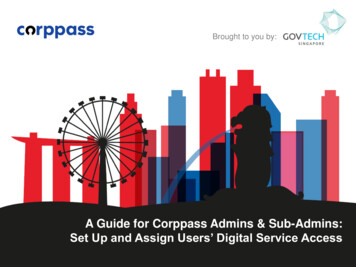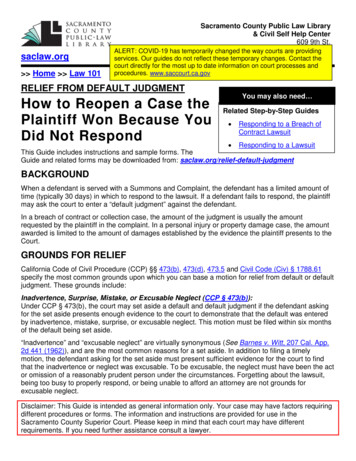
Transcription
saclaw.orgSacramento County Public Law Library& Civil Self Help Center609 9th St.Sacramento,CA 95814ALERT: COVID-19 has temporarily changed the waycourts are providing(916)874-6012services. Our guides do not reflect these temporary changes.Contactthe Home Law 101court directly for the most up to date information on court processes andprocedures. www.saccourt.ca.govRELIEF FROM DEFAULT JUDGMENTHow to Reopen a Case thePlaintiff Won Because YouDid Not RespondYou may also need Related Step-by-Step Guides Responding to a Breach ofContract Lawsuit Responding to a LawsuitThis Guide includes instructions and sample forms. TheGuide and related forms may be downloaded from: saclaw.org/relief-default-judgmentBACKGROUNDWhen a defendant is served with a Summons and Complaint, the defendant has a limited amount oftime (typically 30 days) in which to respond to the lawsuit. If a defendant fails to respond, the plaintiffmay ask the court to enter a “default judgment” against the defendant.In a breach of contract or collection case, the amount of the judgment is usually the amountrequested by the plaintiff in the complaint. In a personal injury or property damage case, the amountawarded is limited to the amount of damages established by the evidence the plaintiff presents to theCourt.GROUNDS FOR RELIEFCalifornia Code of Civil Procedure (CCP) §§ 473(b), 473(d), 473.5 and Civil Code (Civ) § 1788.61specify the most common grounds upon which you can base a motion for relief from default or defaultjudgment. These grounds include:Inadvertence, Surprise, Mistake, or Excusable Neglect (CCP § 473(b)):Under CCP § 473(b), the court may set aside a default and default judgment if the defendant askingfor the set aside presents enough evidence to the court to demonstrate that the default was enteredby inadvertence, mistake, surprise, or excusable neglect. This motion must be filed within six monthsof the default being set aside.“Inadvertence” and “excusable neglect” are virtually synonymous (See Barnes v. Witt, 207 Cal. App.2d 441 (1962)), and are the most common reasons for a set aside. In addition to filing a timelymotion, the defendant asking for the set aside must present sufficient evidence for the court to findthat the inadvertence or neglect was excusable. To be excusable, the neglect must have been the actor omission of a reasonably prudent person under the circumstances. Forgetting about the lawsuit,being too busy to properly respond, or being unable to afford an attorney are not grounds forexcusable neglect.Disclaimer: This Guide is intended as general information only. Your case may have factors requiringdifferent procedures or forms. The information and instructions are provided for use in theSacramento County Superior Court. Please keep in mind that each court may have differentrequirements. If you need further assistance consult a lawyer.
saclaw.orgRelief from Default Judgment Home Law 101Examples of excusable neglect include: Illness that disables the party from responding or appearing in courtFailure to respond because you relied on your attorney to do soFailure to appear at trial because you relied on misinformation provided by a court officerA mistake of fact occurs when a person understands the facts to be other than they are. A mistake oflaw occurs when a person knows the facts as they are, but has a mistaken belief as to the legalconsequences of those facts. Ignorance of the law or negligence in researching the law does notgenerally constitute an excusable mistake, and therefore is not usually grounds for relief from adefault; however, the more confusing or obscure the critical fact or point of law that caused thedefault, the more likely it becomes the court will find the mistake to be excusable.Surprise occurs when a party is placed in an injurious legal situation, through no fault or negligence ofhis or her own, that ordinary prudence would not have guarded against.Typically, in the day-to-day handling of these motions, the court does not focus on whether a problemis a “mistake” or “inadvertence” or “excusable neglect,” but rather looks at what went wrong, andwhether it is reasonable under the circumstances to relieve the requesting party from the judgment.Party not given actual notice in time to defend (CCP § 473.5):Even if service of the summons is proper, sometimes it does not result in “actual notice” to a party intime to defend their case. “Actual notice” means the party genuinely does not know of the litigation, soto show a lack of actual notice a defendant would need to demonstrate to the court that he or shelacked knowledge that the lawsuit existed. This lack of knowledge cannot be caused by thedefendant’s inexcusable neglect or avoidance of service. Motions based on CCP § 473.5 must befiled within a reasonable period of time, and that time must be within two years of the date of thejudgment. Goya v. P.E.R.U. Enterprises, 87 Cal. App. 3d 886 (1978).Party not given actual notice in time to defend action brought by a debt buyer (Civ § 1788.61):Similar to the grounds discussed above, Civ § 1788.61 permits a defendant to set aside a default ordefault judgment when service of a summons did not result in actual notice in time to defend casesbrought by a debt buyer. This code section applies only if you were sued by debt buyer, such as acollection agency or law firm that purchased the debt from the original creditor. Motions brought underthis code section must be filed within either 6 years after the entry of default, or 180 days of the firstactual notice of the action, whichever is earlier.If this default judgment occurred because you were the victim of identity theft, or this is a case ofmistaken identity (e.g., the judgment should be against someone else who shares your name), youhave 180 days from the first actual notice of the case to ask the court to set aside the defaultjudgment.Void Judgments (CCP § 473(d)):The court may, on its own motion or the motion of either party, set aside any void judgment or order.A judgment or order may be void if the issuing court lacked subject matter jurisdiction over the action,if the court lacked personal jurisdiction over the defendant, if the judgment or order granted relief thatthe court had no power to grant, or if the judgment was procured by fraud on the court. Although thereare numerous ways in which a judgment may be void, a common way default judgments are found to2saclaw.org/relief-default-judgment
saclaw.orgRelief from Default Judgment Home Law 101be void is if the judgment was obtained after improper or fraudulent service, resulting in a lack ofpersonal jurisdiction over the defendant.A judgment may be void on its face if review of the court file reveals that the judgment was improperlyentered, for example, if a default judgment is entered against a defendant less before 30 days havelapsed since the date of service shown on the Proof of Service of Summons. A judgment may be voidin fact if the judgment appears to be properly entered in the court file, but evidence shows that thejudgment was improperly entered, for example, if a defendant can establish that the Summons wasnever served.A judgment void on its face is subject to set aside at any time, (see Nagel v. P & M Distributors, Inc.,273 Cal. App. 2d 176 (1969)), however courts typically require that a motion to set aside a judgmentthat is void in fact to be filed within a reasonable period of time. In determining the outer limits of whatconstitutes a reasonable time, courts have referred by analogy to statutory limitation periods. Somecourts have applied the six-month period applicable to motions under CCP § 473(b) (see, e.g., WellsFargo & Co. v. City etc. of S.F., 25 Cal. 2d 37 (1944)). Other courts have applied the two-year or 180day period applicable to motions under CCP § 473.5, particularly when the judgment or order is voidin fact due to an extrinsic defect in service (see, e.g., Rogers v. Silverman, 216 Cal. App. 3d 1114(1989)). Given the wide discretion of the court and the lack of consensus of what constitutes areasonable period of time, it is typically best to promptly file any motion seeking to set aside a voidjudgment.STEP-BY-STEP INSTRUCTIONSStep 1: Collect Supporting DocumentationMotions to set aside default judgments typically include one or more documents attached as exhibits,which provide the court with evidence supporting your claims. You may want to collect thesedocuments ahead of time, so that you may accurately describe them in your pleadings. Thedocuments you will attach vary depending on your situation, the grounds you are claiming, and whatyou are attempting to prove.For example, you may want to collect: Evidence of your residential or business address on the purported date of service, if you areclaiming that you did not receive actual notice because service occurred at an old address;Medical documentation if you claim excusable neglect based on a medical condition;Proof that you are not the party named in the judgment if you are claiming mistaken identity;Identity Theft Victim’s Complaint and Affidavit or a copy of a related police report if you areclaiming identity theft (NOTE: If you are claiming identity theft under Civ § 1788.61, one ofthese must be included with your motion);Documentation of any misinformation you received from a court officer, etc.Remember, you are not trying to convince the court why you should win the lawsuit at this point. Youare attaching only documents that prove why the default should be set aside. If your motion isgranted, you will have an opportunity to present your defense to the lawsuit.3saclaw.org/relief-default-judgment
saclaw.orgRelief from Default Judgment Home Law 101Step 2: Prepare the Motion2.1 Motions in GeneralA request to set aside a default is made through a motion. A “motion” is a request made in a caseasking the court to issue an order of some sort. Most motions are in writing. With few exceptions(such as in family law cases), there is no Judicial Council form for making a motion. Instead, themotion must be typed on 28-line pleading paper. A written motion consists of four parts:1)2)3)4)Notice of Motion;Motion;Points and Authorities; andDeclarationThe Notice of Motion lets the opposing party know when and where the motion is scheduled to beheard, while the Motion lets the court and the opposing party know what is being requested. ThePoints and Authorities explains to the court and the opposing party the legal basis of the motion, whilethe Declaration provides evidence, sworn under penalty of perjury, supporting the motion.The first two parts, the Notice of Motion and Motion, are typically combined together in the samedocument, while the Points and Authorities and Declaration are often separate documents. In manyinstances, however, they may be combined together into the same document, as in the case of thesample included in this Guide.2.2 Modify the Template MotionThere is no Judicial Council form for this procedure. Instead, the relevant documents must be typedon 28-line pleading paper. A Customizable template may be downloaded from this link: Notice of Motion and Motion to Set Aside Default, Memorandum of Points and Authorities,and Declaration in Support of MotionThe template includes Points and Authorities for all the grounds listed above. The template alsoincludes arguments to be used if you are seeking to quash the service of summons. These are usedin instances where the service itself was improper (e.g., it never took place; substituted service wasupon a minor child, etc.). In your case, you will likely not be making all of these arguments. You mustread the template very carefully, and select only the grounds and arguments that fit your situation.This sample includes a number of checkboxes that can be filled in by hand. Although you may usethis form as is, it will be substantially shortened and look cleaner if you download the customizabletemplate of the motion from the link listed above, and remove the instructions in parenthesis,checkboxes and associated text that are not appropriate to your case, and underlining (after filling inthe underlined sections, of course).Although the declaration (the last part of the motion) can be used as a checkbox form, it is generallypreferable if you use your own words to explain the facts of your case. The checkbox form does notanticipate all possible facts that might arise, and is best used as a guideline for some of the pointsthat should be made in your declaration. The declaration is the most important part of the motion,because the declaration presents to the court the evidence that you wish the court to consider when4saclaw.org/relief-default-judgment
saclaw.orgRelief from Default Judgment Home Law 101ruling on your motion. Because it is your responsibility as the moving party to prove the basis of yourmotion, the better your declaration, the more likely it is that your motion will be granted by the court.In Sacramento, the Notice of Motion and Motion must include the paragraph from Local Rule 1.06 (D)informing the parties of the tentative ruling system. That language is included in the sample at the endof this Guide.2.3 Setting the Date of the MotionIn Sacramento, the party requesting the default be set aside is responsible for setting the date forhearing the motion. There are two very important deadlines you must consider when setting the dateof a motion: the filing deadline and the service deadline.Filing Deadline: The motion must be filed with the court at least sixteen court days prior to themotion date (CCP § 1005). Court days are Monday through Friday, excluding court holidays. Todetermine whether a particular filing date will meet this deadline, start with your desired hearing dateand count backward (CCP § 12c) sixteen court days. Day one is the court day prior to the hearing.The sixteenth court day prior to the hearing is the last possible date that the motion can be filed withthe court.For example, suppose you wanted to have your motion heard on June 18, 2012. You would startcounting backward using June 15, 2012 as day one. Do not count weekends or court holidays (thereis only one court holiday in this example, which is Memorial Day, May 28). Your sixteenth court daybefore the hearing would be May 24, 2012, which would be the latest that the motion could be filed.Service Deadline: Prior to filing the motion with the court, all other attorneys, or self-representedparties in a case must be served with a copy of the motion. This means that someone over the age of18 who is not a party in the case must either personally deliver a copy of the motion and relateddocuments to the attorney or self-represented party or mail a copy of the motion and relateddocuments to the party by first class mail.5saclaw.org/relief-default-judgment
saclaw.orgRelief from Default Judgment Home Law 101If the motion is personally served, the service must be at least sixteen court days prior to the date ofthe motion, the same as the minimum filing deadline.If the motion is served by first-class mail, additional time is added to the calculation, depending onwhere the mail originates and where it is sent (CCP § 1005). For example, if the documents aremailed from California to an address in California, five calendar days are added before the sixteencourt days. Calendar days include weekends and holidays, but if the final day lands on a weekend orholiday, it is rolled over to the previous court day. So, if June 18, 2012 was the hearing date, thesixteenth court day before would be May 24, 2012, but counting back five more calendar days resultsin Saturday, May 19, 2012. Because the fifth day fell on a weekend (or holiday), the deadline forservice rolls back to May 18, 2012, the last court day before the deadline.When choosing the date of your motion, be sure that you have left enough time for the motion to beboth served and filed in a timely fashion.2.4 Determining the Department to Hear and the Time of the MotionMotions to set aside a default are heard in Department 53 at 2:00 p.m. or Department 54 at 9:00 a.m.,depending on your case number, Monday through Friday except for holidays. To determine whetheryour motion is in department 53 or 54: For NEW CASES filed after January 1, 2013: If your case number is ends in an odd number,then your law and motion department is 53 at 2:00 p.m. If it ends in an even number, it isdepartment 54 at 9:00 a.m. All Law and Motion matters for CASES filed prior to January 1, 2013 shall be heard by the Lawand Motion department previously assigned.Step 3: Prepare Your Proposed Responsive PleadingA copy of your proposed responsive pleading must be attached to your motion as an exhibit. Yourresponsive pleading is most likely an Answer, but other options are available. For more information,see the guide on Responding to a Lawsuit on our website at saclaw.org/respond-to-lawsuit.Step 4: Copy and Assemble Your DocumentsMake four copies of your documents, including your motion, points and authorities, declaration, andexhibits. Your exhibits will include any documents you have that help prove your claims (see Step 1),as well as your proposed responsive pleading (see Step 3).Assemble your copies into packets. Each packet will include, in this order: MotionPoints and authorities6saclaw.org/relief-default-judgment
saclaw.orgRelief from Default Judgment Home Law 101 DeclarationExhibitsAttaching ExhibitsOne packet should include all your original documents;the other three packets should include only photocopies.Staple each set of photocopies, but leave the packet oforiginals unstapled.Step 5: Have the Motion ServedYour motion must be served by a person over the age of18 who is not a party to the case. Your server mustcomplete a proof of service form, either Proof of Serviceby First Class Mail (POS-030) or Proof of PersonalService (POS-020). For more information on theseProofs of Service, see the guides on our website atsaclaw.org/mail-service, and saclaw.org/personalservice, respectively.In Sacramento County, the exhibitsin one set of photocopies must beseparated by a rigid sheet of cardstock with a tab identifying the letterof the exhibit on the bottom. TheLaw Library sells exhibit tabs at theCirculation Desk.Exhibits for the original and othertwo copies should be separated bya blank piece of pleading paperwith their exhibit letter or numbertyped or written at the bottom of thepage.The proof of service form should be completely filled out, but not signed. Make a copy of theunsigned proof of service before proceeding.The server must then personally deliver or mail a copy of the motion along with a copy of theunsigned proof of service form on other party’s attorney (or the other party, if they do not have anattorney). The unsigned proof of service form can be attached as the last page of the motion.The server then signs the Proof of Service form, and gives the signed Proof of Service to you.Step 6: Copy the Signed Proof of ServiceMake three (3) copies of the signed proof of service. It is not necessary to copy the instruction page.Step 7: Filing/FeesFile your motion and proof of service at the Law & Motion Civil Filing Window in Room 212 on thesecond floor of the Hall of Justice building, located at 813 6th Street in downtown Sacramento.If this is the first document that you have filed in this case, the court will assess a first appearance feewhen you file your motion. This fee depends on the amount the plaintiff alleges is owed in the originalComplaint. If the Complaint sought up to 10,000, the first appearance fee is (as of the date of thisguide) 225. If the Complaint sought over 10,000, but not over 25,000, the first appearance fee is 370. Cases seeking over 25,000 have a first appearance fee of 435. If you have already paid thisfirst appearance fee, the fee for filing a motion is 60. Current fees are available on the SacramentoCounty Superior Court’s website (www.saccourt.ca.gov/fees/docs/fee-schedule.pdf), and are due atthe time you file your motion unless you qualify for a waiver of your court fees. For more information,see the Step-by-Step guide on Fee Waivers on our website at ault-judgment
saclaw.orgRelief from Default Judgment Home Law 101Step 8: Opposition and ReplyIf any opposing counsel or self-represented party opposes your motion, he or she may serve and filean opposition at least nine court days prior to your motion. No fee is required to file an opposition.The opposition contains a memorandum of points and authorities and usually a declaration, but doesnot need the notice of motion or motion. Be sure to check your mail, and read any documents youreceive carefully.If the other attorney or party opposes your motion, you may choose to serve and file a reply to theopposition at least five court days prior to the motion. CCP § 1005. No fee is required to file a reply.The reply should carefully address any points made by the opposition, especially if that point was notoriginally addressed in your motion. See the Step-by-Step guide on Writing, Scheduling, andOpposing Motions on our website at saclaw.org/motions-general for more information.Step 9: Tentative RulingsPursuant to Local Rule 1.06, the court will make a tentative ruling on the merits of your matter by 2:00p.m. the court day before the hearing. You may read the tentative ruling online or may obtain thetentative ruling over the telephone by calling Department 53 (916-874-7858) or Department 54 (916874-7848) to have a clerk read the ruling to you. For more information, see the Sacramento CountySuperior Court’s website at ve.aspx.Closely review the tentative ruling. Since you are asking the court for to set aside the default, you arelooking for your motion to be “GRANTED.” If the court does not grant your request, your motion willbe “DENIED.” Even if your request is granted, be sure to read the tentative ruling very carefully, sinceit will likely contain other important information such as if and when you need to serve and file yourproposed Answer (or other response).If you are happy with the tentative ruling, you do not need to do anything. You won’t have to go tocourt unless ordered to appear in the tentative ruling or unless the other side calls you and the courtbetween 2:00 p.m. and 4:00 p.m. the court day before your hearing date to request an oral argumentin front of the judge. If that happens, you should go to the court hearing and be prepared to arguewhy your motion should be granted.If you are not happy with the tentative ruling, and wish to present arguments in front of the judge, youmust contact the court clerk (Department 53 (916-874-7858) or Department 54 (916-874-7848)) andall opposing counsel and/or self-represented parties before 4:00 p.m. the court day before the hearingto let each know that you are requesting oral argument on the motion. If you do not call the court andall opposing counsel and/or self-represented parties by 4:00 p.m. on the court day before the hearing,no hearing will be held. If neither you nor the opposing counsel or self-represented party requests oralargument, the court will simply make the tentative ruling the order of the court.8saclaw.org/relief-default-judgment
saclaw.orgRelief from Default Judgment Home Law 101FOR HELPSacramento County Public Law Library Civil Self Help Center609 9th Street, Sacramento center/(916) 476-2731 (Appointment Request Line)Services Provided: The Civil Self Help Center provides general information and basic assistance topeople without attorneys on a variety of civil legal issues. All assistance is provided by telephone orZoom videoconference. Visit “Issues We Can And Cannot Assist With” (saclaw.org/cshc-services) fora list of qualifying cases.Eligibility: Must be a Sacramento County resident or have a qualifying case in the Sacramento CountySuperior Court.FOR MORE INFORMATIONOn the Web:For information about the Sacramento County Superior Court’s motion requirements, neral.aspx.At the Law tronic Access: On the Law Library’s computers, using OnLaw.995.C34Chap.California Practice Guide: Civil Procedure Before Trial KFC 995 .W45 Chap. 5.Electronic Access: On the Law Library’s computers, using WestlawNext.California Forms of Pleading and Practice KFC 1010 .A65 C3 (Ready Ref) Chap. 489.Electronic Access: On the Law Library’s computers, using Lexis Advance.California Civil Practice: Procedure KFC 995 .A65 B3 Chap. 29.Electronic Access: On the Law Library’s computers, using WestlawNext.California Pretrial Civil Procedure KFC 995 .M38 Chap. 36.Electronic Access: On the Law Library’s computers, using Lexis Advance.California Points and Authorities KFC 1010 .B4 (Ready Ref) Chap. 70.Electronic Access: On the Law Library’s computers, using Lexis Advance.Younger on California Motions KFC 1012 .C35 Chap. 26.Electronic Access: On the Law Library’s computers, using WestlawNext.IF YOU HAVE QUESTIONS ABOUT THIS GUIDE, OR IF YOU NEED HELP FINDING OR USING THEMATERIALS LISTED, DON’T HESITATE TO ASK A REFERENCE LIBRARIAN.H:\public\LRG-SBS\SbSs\Relief from Default\SBS Motion to Set ed 12/20 mpj38.
saclaw.orgRelief from Default Judgment Home Law 101ATTACHMENTS: FORMS AND INSTRUCTIONSThere is no Judicial Council form for this procedure. Instead, the relevant documents must be typedon 28-line pleading paper. A Customizable template may be downloaded from this link: Notice of Motion and Motion to Set Aside Default, Memorandum of Points and Authorities,and Declaration in Support of MotionSample filled-in forms with instructions are available at the end of this Guide.10saclaw.org/relief-default-judgment
You may print the template and fill in the blanks by hand, or you may type the document using the formmotion as a template. If you are typing the document, you may delete the checkboxes and accompanyingtext for anything that you are not asserting.123Doug Defendant123 Main StreetSacramento, CA 95814916-555-987645Your name, address, phonenumber, and party designation.Defendant In Pro Per6Identify the basis of the motion. These checkboxescorrespond to the checkboxes in the Points andAuthorities (the second section).789SUPERIOR COURT OF CALIFORNIA COUNTY OF SACRAMENTOIdentify the plaintiff(s), defendant(s), andcase number.10Peter Plaintiff,11Plaintiff,12vs.13Doug Defendant,14Defendant1516Insert the date, time and department ofthe hearing, as well as the date that thelawsuit was first filed.1718this box or delete the checkbox if youCheckare requesting that the court quash service19Summons.of the))))))))))))))))Case No.: 34-2011-00012345NOTICE OF MOTION AND MOTION TOSET ASIDE DEFAULT AND DEFAULTJUDGMENT, IF ENTERED: CCP §473(b) CCP §473.5 Civ. §1788.61 CCP §473(d) AND QUASH SERVICE OFSUMMONS (CCP §418.10);POINTS AND AUTHORITIES;DECLARATIONDate: November 12, 2011Dept/Time: Dept. 53 at 2:00 p.m. Dept. 54 at 9:00 a.m.)) Date Complaint was filed: January 17, 2011202122TO EACH PARTY AND TO THE COUNSEL OF RECORD FOR EACH PARTY:YOU ARE HEREBY NOTIFIED THAT at the above-captioned date and time and23department in the courthouse located at 813 Sixth Street, Sacramento, California that Defendant will24move the court for an order requesting that the Default and, if entered, Default Judgment be set aside,25 as well as an order quashing the service of the Summons due to lack of jurisdiction pursuant toCCP § 418.10(a)(1). This motion is made on the following grounds:26Check the box(es) that Inadvertence, surprise, mistake, or excusable neglect (CCP §473(b));identify the27basis foryour motion. (Or delete Service of the Summons did not result in actual notice (CCP §473.5);the checkboxesand the28selections that do notdescribe the basis forMOTION TO SET ASIDE- 1your motion.)
12 Service of the Summons did not result in actual notice in time to defend actionbrought by a debt buyer (Civ. §1788.61);If you are arguing any otherstatutory basis for set aside,3 The judgment and/or default is void (CCP§473(d));checkthe box and identify the4 Other Grounds:basis of the set aside.5This motion will be based upon this notice, the attached points and authorities and declaration of6Doug Defendant, and the records and files in this action.7The name of the person making thedeclaration (most likely you) goes here.Pursuant to Local Rule 1.06 (A) the court will make a tentative ruling on the merits of this8matter by 2:00 p.m., the court day before the hearing. The complete text of the tentative rulings for910the department may be downloaded off the court’s website. If the party does not have online access,11they may call the dedicated phone number for the department as referenced in the local telephone12directory between the hours of 2:00 p.m. and 4:00 p.m. on the court day before the hearing and13receive the tentative ruling. If you do not call the court and the opposing party by 4:00 p.m. the court14day before the hearing, no hearing will be held.151617 local rules of the Sacramento Superior CourtTherequires this notice about the tentative ruling system18included with each motion. Other courts havebedifferent requirements.19Dated:October 1, 201120Doug DefendantDefendant, In Pro Per212223Date, sign, and print your name where indicated.24As in the rest of this document, if you are typing the document using the form motion as atemplate, you may delete checkboxes for anything you are asserting, and checkboxes withaccompanying text for anything that you are not asserting. This will provide a shorter,cleaner document.25262728MOTION TO SET ASIDE- 2
The Points and Authorities explains the legal basis for your motion.The background explains how the def
GROUNDS FOR RELIEF . California Code of Civil Procedure (CCP) §§ 473(b), 473(d), 473.5 and Civil Code (Civ) § 1788.61 specify the most common grounds upon which you can base a motion for relief from default or default judgment. These grounds include: Inadvertence, Surprise, Mistake, or Excusable Neglect (CCP § 473(b)):
